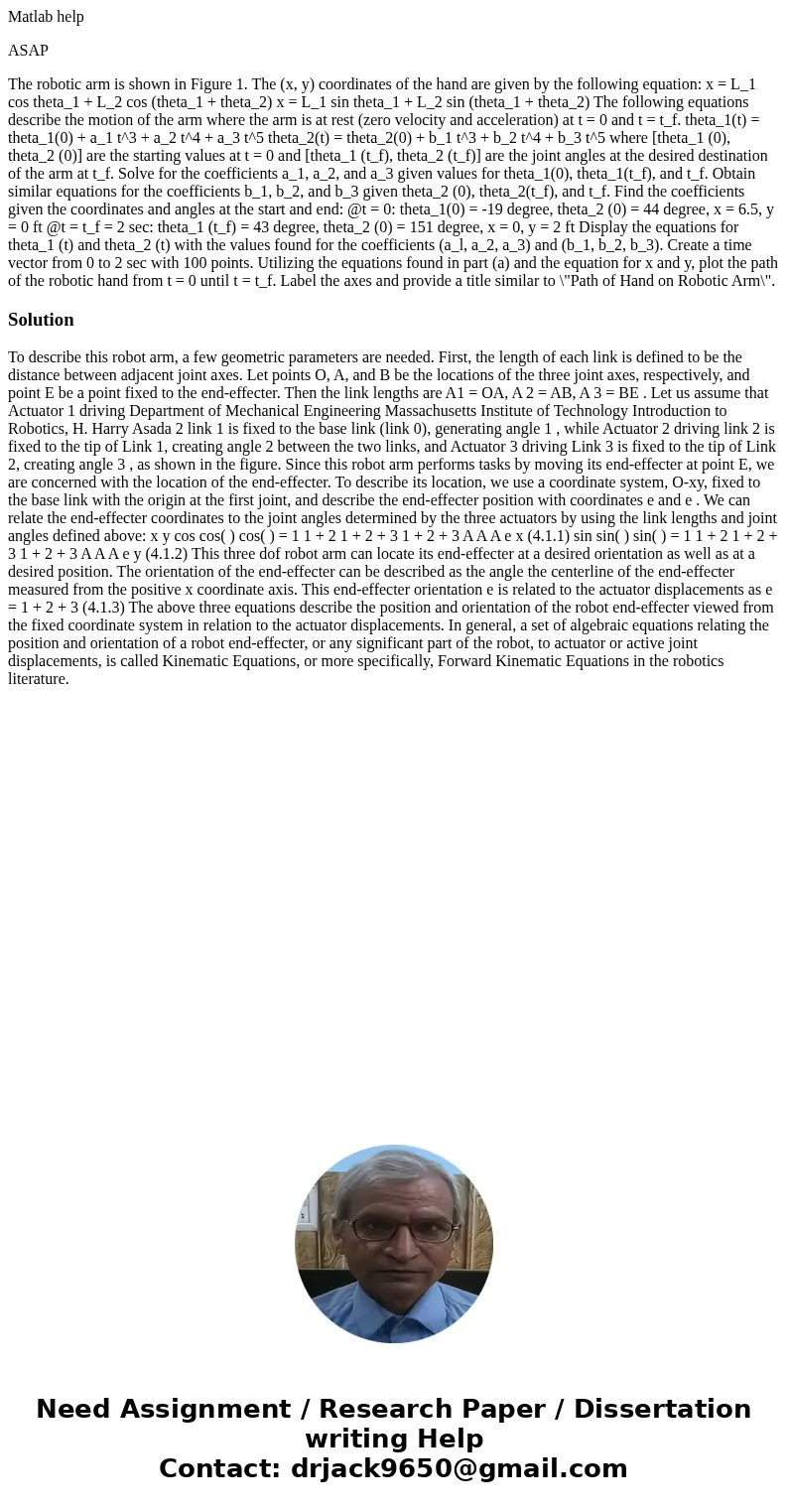Matlab help ASAP The robotic arm is shown in Figure 1 The x
Matlab help
ASAP
The robotic arm is shown in Figure 1. The (x, y) coordinates of the hand are given by the following equation: x = L_1 cos theta_1 + L_2 cos (theta_1 + theta_2) x = L_1 sin theta_1 + L_2 sin (theta_1 + theta_2) The following equations describe the motion of the arm where the arm is at rest (zero velocity and acceleration) at t = 0 and t = t_f. theta_1(t) = theta_1(0) + a_1 t^3 + a_2 t^4 + a_3 t^5 theta_2(t) = theta_2(0) + b_1 t^3 + b_2 t^4 + b_3 t^5 where [theta_1 (0), theta_2 (0)] are the starting values at t = 0 and [theta_1 (t_f), theta_2 (t_f)] are the joint angles at the desired destination of the arm at t_f. Solve for the coefficients a_1, a_2, and a_3 given values for theta_1(0), theta_1(t_f), and t_f. Obtain similar equations for the coefficients b_1, b_2, and b_3 given theta_2 (0), theta_2(t_f), and t_f. Find the coefficients given the coordinates and angles at the start and end: @t = 0: theta_1(0) = -19 degree, theta_2 (0) = 44 degree, x = 6.5, y = 0 ft @t = t_f = 2 sec: theta_1 (t_f) = 43 degree, theta_2 (0) = 151 degree, x = 0, y = 2 ft Display the equations for theta_1 (t) and theta_2 (t) with the values found for the coefficients (a_l, a_2, a_3) and (b_1, b_2, b_3). Create a time vector from 0 to 2 sec with 100 points. Utilizing the equations found in part (a) and the equation for x and y, plot the path of the robotic hand from t = 0 until t = t_f. Label the axes and provide a title similar to \"Path of Hand on Robotic Arm\".Solution
To describe this robot arm, a few geometric parameters are needed. First, the length of each link is defined to be the distance between adjacent joint axes. Let points O, A, and B be the locations of the three joint axes, respectively, and point E be a point fixed to the end-effecter. Then the link lengths are A1 = OA, A 2 = AB, A 3 = BE . Let us assume that Actuator 1 driving Department of Mechanical Engineering Massachusetts Institute of Technology Introduction to Robotics, H. Harry Asada 2 link 1 is fixed to the base link (link 0), generating angle 1 , while Actuator 2 driving link 2 is fixed to the tip of Link 1, creating angle 2 between the two links, and Actuator 3 driving Link 3 is fixed to the tip of Link 2, creating angle 3 , as shown in the figure. Since this robot arm performs tasks by moving its end-effecter at point E, we are concerned with the location of the end-effecter. To describe its location, we use a coordinate system, O-xy, fixed to the base link with the origin at the first joint, and describe the end-effecter position with coordinates e and e . We can relate the end-effecter coordinates to the joint angles determined by the three actuators by using the link lengths and joint angles defined above: x y cos cos( ) cos( ) = 1 1 + 2 1 + 2 + 3 1 + 2 + 3 A A A e x (4.1.1) sin sin( ) sin( ) = 1 1 + 2 1 + 2 + 3 1 + 2 + 3 A A A e y (4.1.2) This three dof robot arm can locate its end-effecter at a desired orientation as well as at a desired position. The orientation of the end-effecter can be described as the angle the centerline of the end-effecter measured from the positive x coordinate axis. This end-effecter orientation e is related to the actuator displacements as e = 1 + 2 + 3 (4.1.3) The above three equations describe the position and orientation of the robot end-effecter viewed from the fixed coordinate system in relation to the actuator displacements. In general, a set of algebraic equations relating the position and orientation of a robot end-effecter, or any significant part of the robot, to actuator or active joint displacements, is called Kinematic Equations, or more specifically, Forward Kinematic Equations in the robotics literature.

 Homework Sourse
Homework Sourse